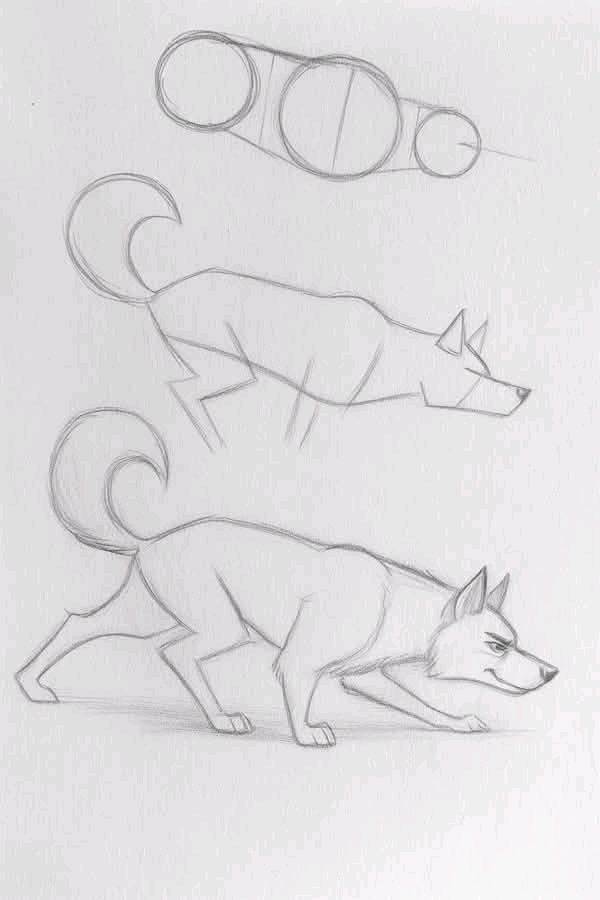DRAWING A DOG IN A THREE STEPS WORKING IN AMBUSH.
 . At first, the volunteer organization was in charge of getting the dogs, housing them, and training them. However, it soon became apparent that the varying levels of experience among the volunteer civilian trainers and the inconsistent courses of training in different locations led to dogs that were often incapable of performing the duties expected of them. At the same time, the military began to show interest in a variety of dog-related roles, both domestically and abroad. As a result, on 16 July 1942, Secretary of War Henry L. Stimson issued a directive that assigned responsibility for procuring and training dogs to the Remount Branch of the Quartermaster Corps (QMC) and expanded their mandate to include the training of dogs for both sentry duty and possible tactical missions as well.
. At first, the volunteer organization was in charge of getting the dogs, housing them, and training them. However, it soon became apparent that the varying levels of experience among the volunteer civilian trainers and the inconsistent courses of training in different locations led to dogs that were often incapable of performing the duties expected of them. At the same time, the military began to show interest in a variety of dog-related roles, both domestically and abroad. As a result, on 16 July 1942, Secretary of War Henry L. Stimson issued a directive that assigned responsibility for procuring and training dogs to the Remount Branch of the Quartermaster Corps (QMC) and expanded their mandate to include the training of dogs for both sentry duty and possible tactical missions as well.
At the outset of the program, DFD and the Remount Branch accepted many different breeds of dogs as long as the dogs were healthy and showed the proper disposition. It was soon discovered, however, that certain breeds were superior to others in performing the types of duties the Army desired, and by 1944, the list of acceptable breeds had shrunk to just seven: German shepherd, Doberman pinscher, Belgian sheepdog, collie, Siberian husky, malamute, and Eskimo dog. These dogs all proved to be hearty in various conditions, eager to work, and capable of the tasks assigned them by the Army.
After narrowing the field of acceptable breeds and consolidating control of the program under the Remount Branch, the stage was set for an expansion and formalization of dog training in the Army. The expertise necessary was put down on paper by one of the organizers of DFD, Mrs. Alene Stern Erlanger, who wrote TM-10-396-WAR DOGS, the Army’s first formal training manual on the subject of dogs in warfare. In addition, by the end of 1942, the QMC opened four dog training facilities at Front Royal, Virginia; Fort Robinson, Nebraska; Camp Rimini, Montana; and San Carlos, California. At these facilities, the Army began an ambitious program to train dogs for duties on the front lines and at home.
The training of the dogs was certainly important in a successful war dog program, but just as important was the training of each animal’s human handler. It was quickly learned that the dogs worked best if they were trained with their handler and assigned to duty as a pair. This allowed for continuity and the formation of a bond between handler and dog, which would be important once they were in the field. It was taught to handlers how to take care of their dogs' food, exercise, ongoing training, and housing. Only handlers were allowed to feed their own dogs, and petting and playing were also limited so that dogs soon considered all but their handler to be a threat. This made the dogs extremely effective at detecting and alerting to unauthorized presences. This sort of training did not always stick with the dog, however, and some became detrained by too much interaction with people on beaches or in other public places.
This is a very easy step
Nice work!
Congratulations @ozonepower! You have completed the following achievement on the Hive blockchain And have been rewarded with New badge(s)
Your next target is to reach 2000 upvotes.
You can view your badges on your board and compare yourself to others in the Ranking
If you no longer want to receive notifications, reply to this comment with the word
STOPCheck out our last posts: